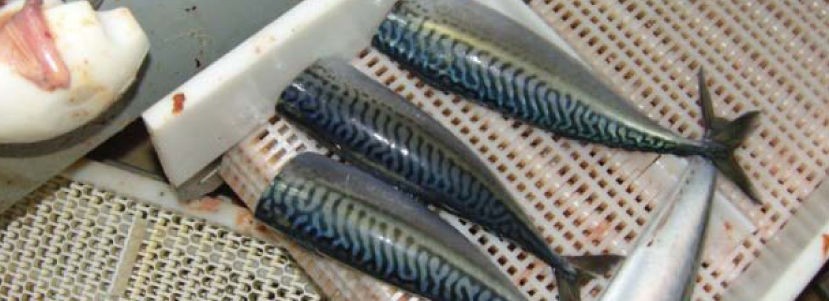Sumarið 2008 var makrílsýnum safnað austur af landinu innan íslenskrar og færeyskrar lögsögu og mat lagt á flokkunareiginleika makrílsins.
Sýnunum var safnað af þremur skipum, þau voru tekin úr skiljara uppá dekki um leið og aflanum var dælt um borð. 30 fiskar af hverju skipi voru mældir á viku. Eftirfarandi þættir voru mældir; heildarlengd, staðallengd, hauslengd, bollengd, stirtla, breidd, hæð, ummál og þyngd auk þess var kyn fiska greint. Fiskurinn var hausaður og slógdreginn um borð í frystiskipunum áður en hann var frystur.

Minnstu makrílarnir voru 29 cm en þeir náðu þó ekki 1% af heildarfjöldanum. Langmest var af makríl sem var 35-39 cm. Makríll sem var 40 cm eða lengri var 20% af heildarfjölda sýna, stærstu sýnin voru 44 cm að lengd og voru 1% af heildarfjöldanum. Makríll verður mest 60 cm langur.
Minnstu makrílarnir voru um 250 grömm en makrílar sem voru undir 300 grömmum voru 4% af heildarsýnafjöldanum. Langflest sýni voru á bilinu 300 – 599 grömm eða 80% af heildinni, þó voru hlutfallslega flest sýni 400-499 grömm eða 31%. Þyngstu sýnin voru yfir 700 grömm og var það þyngsta 790 grömm, hlutfall sýna yfir 700 grömm var 3%. Þegar kynskiptingin er skoðuð sést að 65% af sýnunum var hængur og 35% hrygna.
Fyrstu athuganir á flokkun makríls frá síld hafa verið framkvæmdar með Style-flokkurum. Á Style-flokkurunum flytja flokkunarrásir hráefnið niður á færibönd og er vídd bandanna stillanleg, þannig dettur minnsti fiskurinn fyrstur niður á færibönd en stærri fiskurinn heldur áfram og dettur seinna niður á færibönd sem flytja hann áfram í vinnsluna. Þegar flokkarinn var stilltur eingöngu m.t.t. til að flokka makríl datt síldin strax niður á færiband sem flutti síld og smámakríl í lest, sem síðan var landað til bræðslu. Þegar flokkarinn var stilltur til að flokka bæði síld og makríl var vídd bandanna minni á fremri helmingi flokkarans en mun meiri á aftari helmingi hans, þannig tókst að flokka síldina frá makrílnum en það útilokar þó þann kost að stærðarflokka fiskinn. Gallinn við þessa aðferð er þó að smámakríll slæðist með síldinni og þá þarf að týna hann úr síldaraflanum.
Stærstu útflutningsríkin af frosnum makríl, ásamt hrognum og lifur, eru Noregur og Bretland, þau hafa samanlagt yfir 50% af útflutningsverðmæti í heiminum. Önnur lönd sem flytja út makríl í einhverjum mæli eru Holland, Írland, Máritanía, Kanada, Þýskaland, Bandaríkin og Kína. Kaupendur að þessum afurðum eru að stærstum hluta Japanir, Rússar og Kínverjar.
Stærsti markaðurinn fyrir frosinn makríl er í Japan en 26% af heildarverðmæti markaðarins eru þar. Hins vegar kaupa Japanir ekki makríl af Íslendingum, ástæðan er sú að makríllinn sem leitar inn í íslenska lögsögu er í æti og fitnar mjög hratt eftir hrygninguna en það veldur losi í fiskvöðvanum. Japanir kaupa því haust og vetrarveiddan makríl að mestu leyti af Norðmönnum og Bretum, sem er af meiri og jafnari gæðum.
Þegar markaðir fyrir makrílafurðir eru skoðaðir þykir ljóst að markaðir í Japan og Austur-Evrópu séu fengsælustu markaðirnir bæði hvað varðar magn og verð. Á meðan makríll veiðist einungis á sumrin í íslenskri lögsögu er ekki hægt að selja makríl á Japans-markað en markaðir í Austur-Evrópu sýna sumarveiddum makríl áhuga og voru kaupendur tilbúnir að borga yfir 2500 usd/tonn sumarið 2008.
Verkefnið var styrkt af AVS.

